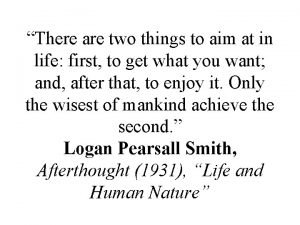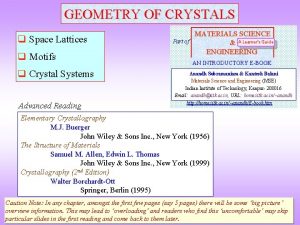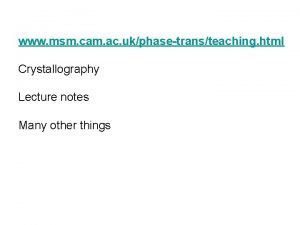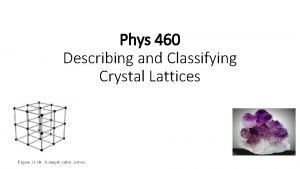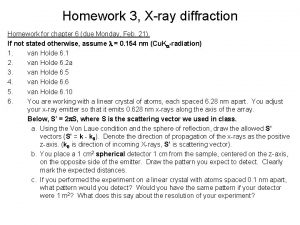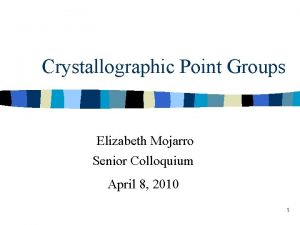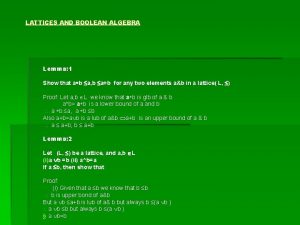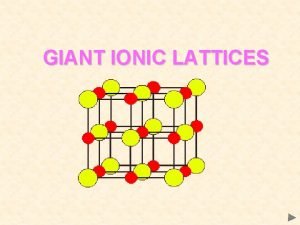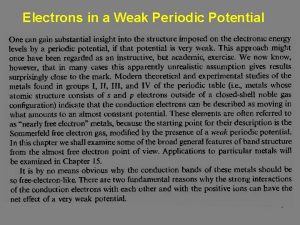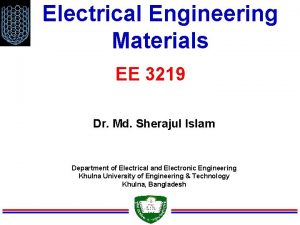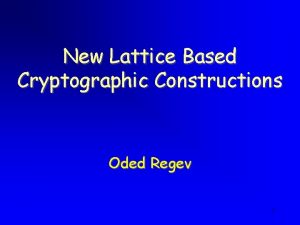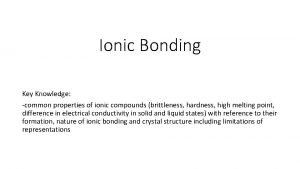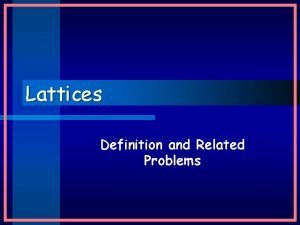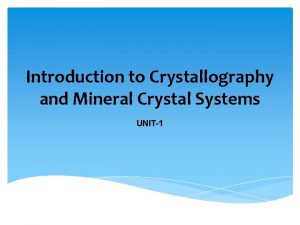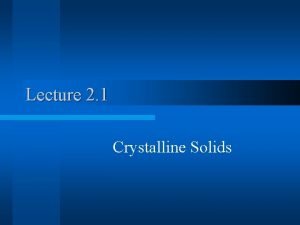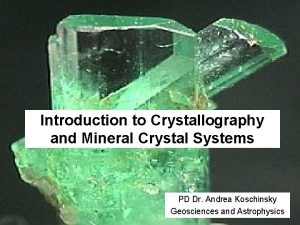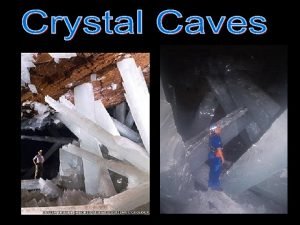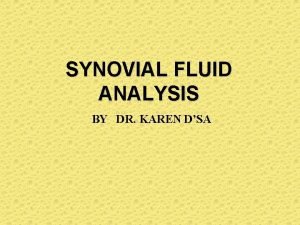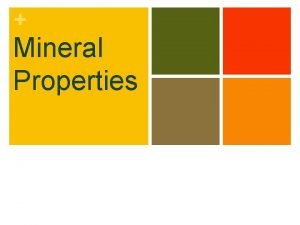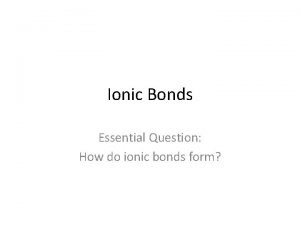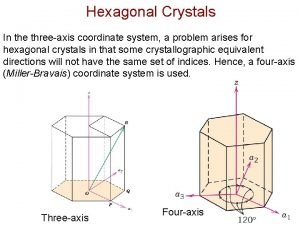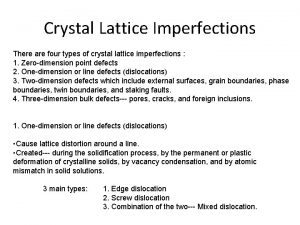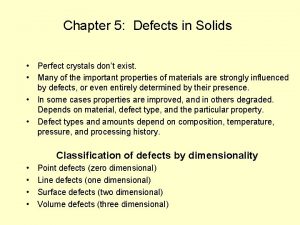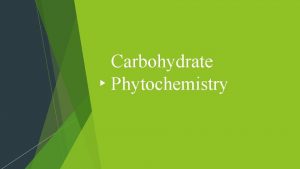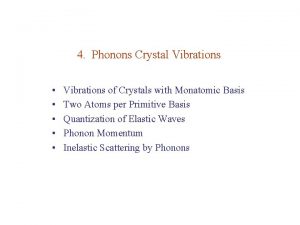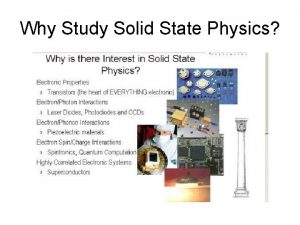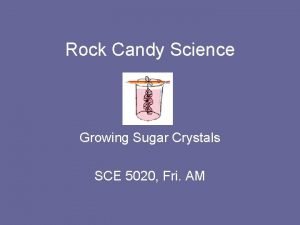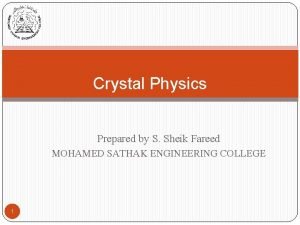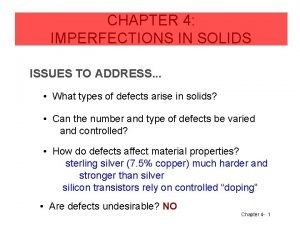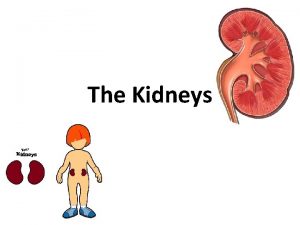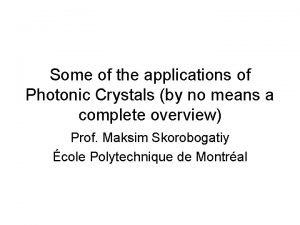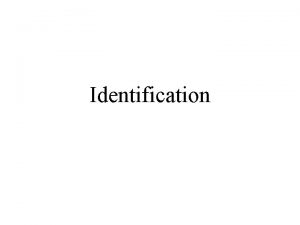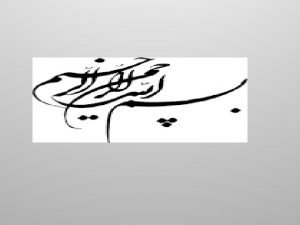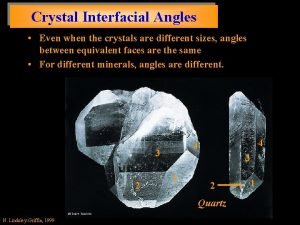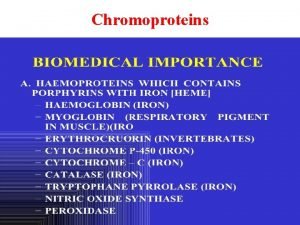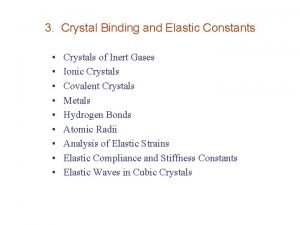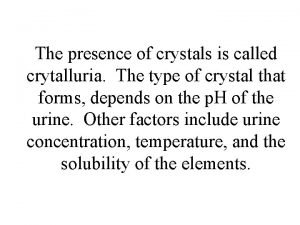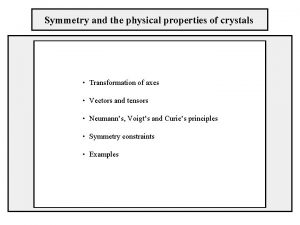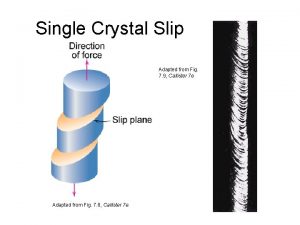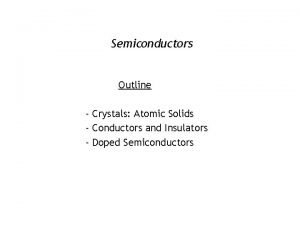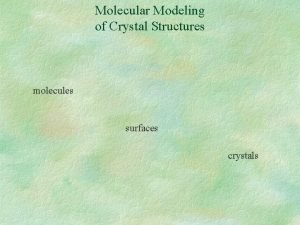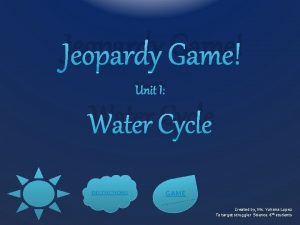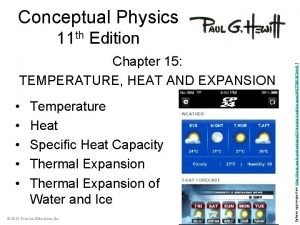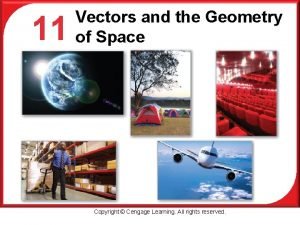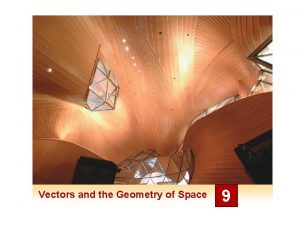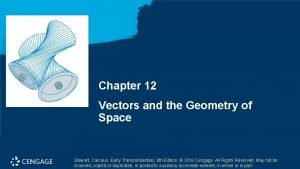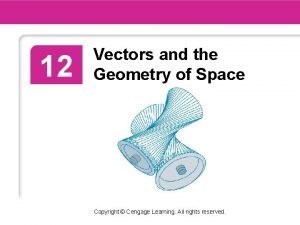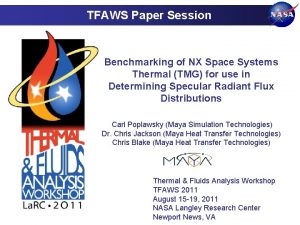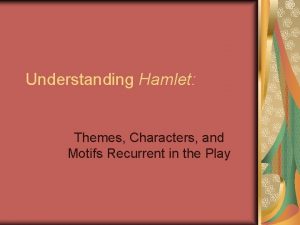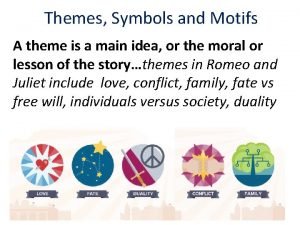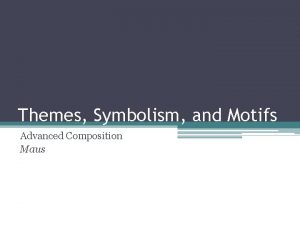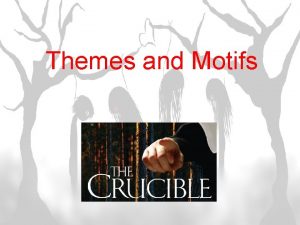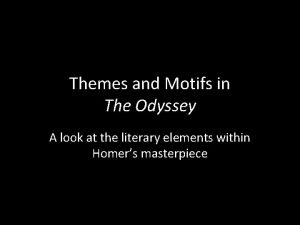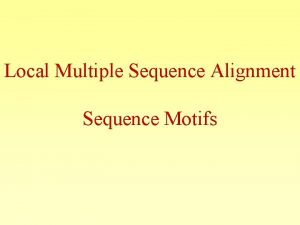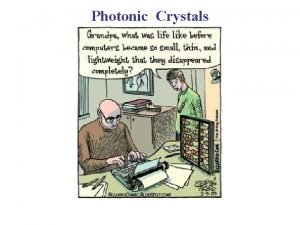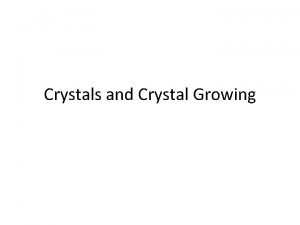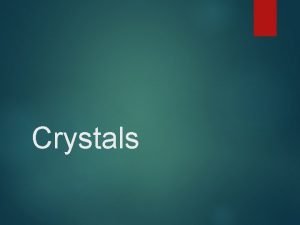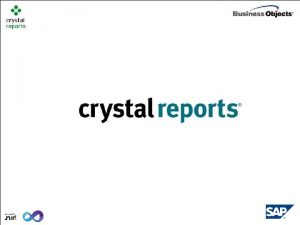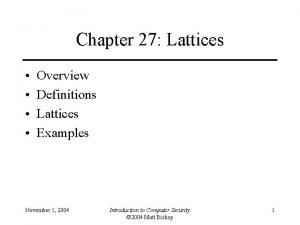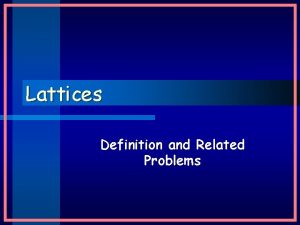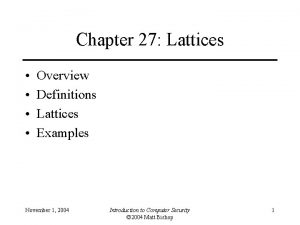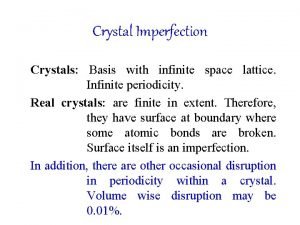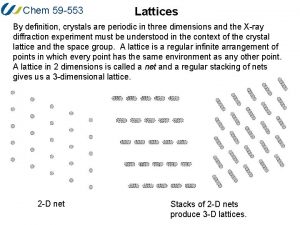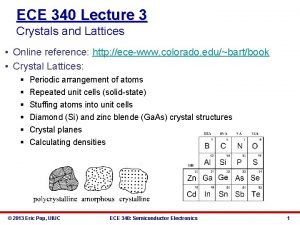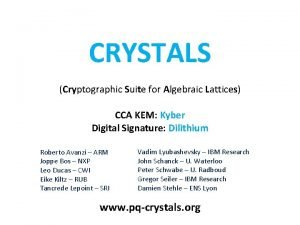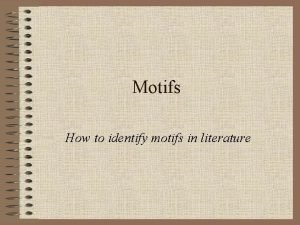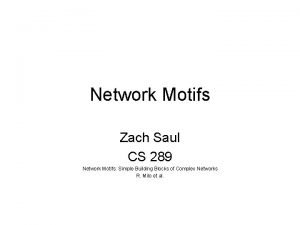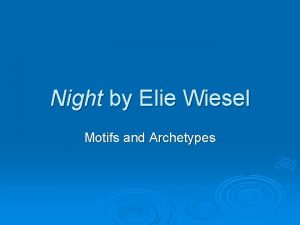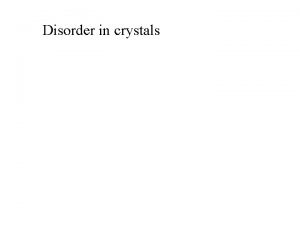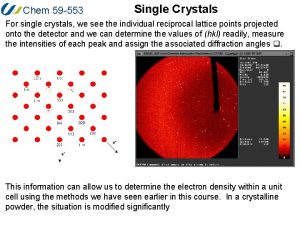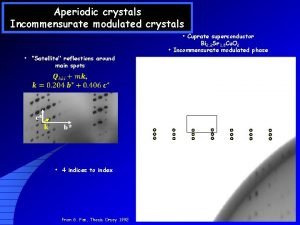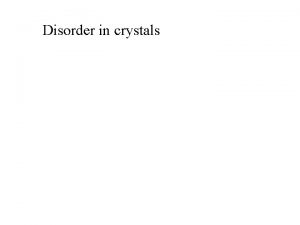GEOMETRY OF CRYSTALS Space Lattices Motifs Crystal Systems





































![In Example of an element with Body Centred Tetragonal Crystal Structure [100] views BCT In Example of an element with Body Centred Tetragonal Crystal Structure [100] views BCT](https://slidetodoc.com/presentation_image_h/8715026c6782f6ca85ceec57392e219e/image-38.jpg)

![Example of an element with Orthorhombic Crystal Structure Ga [010] view [001] view Ga Example of an element with Orthorhombic Crystal Structure Ga [010] view [001] view Ga](https://slidetodoc.com/presentation_image_h/8715026c6782f6ca85ceec57392e219e/image-40.jpg)



![Example of an element with Simple Trigonal Crystal Structure -Hg [111] view -Hg Lattice Example of an element with Simple Trigonal Crystal Structure -Hg [111] view -Hg Lattice](https://slidetodoc.com/presentation_image_h/8715026c6782f6ca85ceec57392e219e/image-44.jpg)





































- Slides: 81

GEOMETRY OF CRYSTALS Space Lattices Motifs Crystal Systems Advanced Reading Part of MATERIALS SCIENCE & A Learner’s Guide ENGINEERING AN INTRODUCTORY E-BOOK Anandh Subramaniam & Kantesh Balani Materials Science and Engineering (MSE) Indian Institute of Technology, Kanpur- 208016 Email: anandh@iitk. ac. in, URL: home. iitk. ac. in/~anandh http: //home. iitk. ac. in/~anandh/E-book. htm Elementary Crystallography M. J. Buerger John Wiley & Sons Inc. , New York (1956) The Structure of Materials Samuel M. Allen, Edwin L. Thomas John Wiley & Sons Inc. , New York (1999) Crystallography (2 nd Edition) Walter Borchardt-Ott Springer, Berlin (1995) Caution Note: In any chapter, amongst the first few pages (say 5 pages) there will be some ‘big picture’ overview information. This may lead to ‘overloading’ and readers who find this ‘uncomfortable’ may skip particular slides in the first reading and come back to them later.

What will you learn in this chapter? This chapter is divided into three ‘sub-chapters’ (file structure)* § In this chapter we shall try to understand a CRYSTAL § We shall consider some ideal mathematical descriptions before taking up examples of real crystals (as we shall see these crystals contain atoms, ions or molecules) § The use of Miller indices for directions and planes in lattices and crystals § How to use X-Ray Diffraction for determination of crystal geometry. * 3. 1 Overview, Geometry of Crystals 3. 2 Miller Indices 3. 3 X-ray Diffraction Caution Note: In any chapter, amongst the first few pages (say 5 pages) there will be some ‘big picture’ overview information. This may lead to ‘overloading’ and readers who find this ‘uncomfortable’ may skip particular slides in the first reading and come back to them later.

What will you learn in this ‘sub-chapter’? § In this sub-chapter we shall try to understand a CRYSTAL. § We shall consider some ideal mathematical descriptions before taking up examples of real crystals (as we shall see these crystals contain atoms, ions or molecules). § We will see that the language of crystallography is applicable to all kinds of crystals (those containing atomic entities, ‘physical properties’ or mathematical ones). § The real crystals we consider in this chapter are also ‘idealizations’ (i. e. The crystals found in practice have various kinds of defects in them and we shall take up topics related to defects in crystals in the chapter on crystal imperfections (Chapter-5)). Note the facets Crystals on the surface of an Al. Co. Fe. Ni alloy To see other kinds of crystals click here Slide 4 (few slides) Video: Dendritic. Let us start by looking at crystallization from a melt (of stearic acid) growth of crystal from melt KDP crystals grown from solution

Why study crystal structures? When we look around much of what we see is non-crystalline (organic things like wood, paper, sand; concrete walls, etc. some of the things may have some crystalline parts!). But, many of the common ‘inorganic’ materials are ‘usually*’ crystalline: ◘ Metals: Cu, Zn, Fe, Cu-Zn alloys ◘ Semiconductors: Si, Ge, Ga. As ◘ Ceramics: Alumina (Al 2 O 3), Zirconia (Zr 2 O 3), Si. C, Sr. Ti. O 3. Also, the usual form of crystalline materials (say a Cu wire or a piece of alumina) is polycrystalline and special care has to be taken to produce single crystals. Polymeric materials are usually not ‘fully’ crystalline. The crystal structure directly influences the properties of the material (as we have seen in the Introduction chapter many additional factors come in). Why study crystallography? Gives a terse (concise) representation of a large assemblage of species Gives the ‘first view’ towards understanding of the properties of the crystal Click here to see how symmetry helps reduce the information content Slide 6 Also see Slide 9 * Many of the materials which are usually crystalline can also be obtained in an amorphous form

We shall consider two definitions of a crystal: 1) Crystal = Lattice + Motif [Lattice decorated with a motif] 2) Crystal = Space Group + Asymmetric unit (+Wyckoff positions)*. The second definition is the more advanced one (the language of crystallographers) and we shall only briefly consider it in this introductory text. The second definition becomes important as the classification of crystals (7 crystal systems) is made based on symmetry and the first definition does not bring out this aspect. Note: Since we have this precise definition of a crystal, loose definitions should be avoided (Though often we may live with definitions like: a 3 D translationally periodic arrangement of atoms in space is called a crystal). Initially we shall start with ideal mathematical crystals and then slowly we shall relax various conditions to get into practical crystals. Note: ‘+’ above does not imply simple addition! It implies a lattice decorated with a motif. More technically it can be thought of as a convolution operation. *Actually, the space group in combination with the Wyckoff positions will do the job (give us the whole crystal). The language of crystallography is one succinctness

Ideal Crystals → Real Crystals → Microstructures → Material → Component Consider only the Geometrical Entity or only the Physical Property Put in Crystalline defects & Free Surface & Thermal Vibration Ideal Crystal Ideal Mathematical Crystal* Some of these aspects will be considered in detail later Consider only the Orientational or Positional Order Crystal** ‘Real Crystal’ Put in Multiple Crystals (Phases) giving rise to interfacial defects ~Microconstituents Put multiple ~microconstituents Add additional residual stress Real materials are usually complex and we start with ideal descriptions Microstructure Material Component Material or Hybrid *, ** Reduced definition of crystals That which is NOT associated with defects (crystalline or interfacial) → e. g. thermal residual stresses

Ideal Crystals → Real Crystals → Microstructures → Material → Component Geometrical entity Ideal Crystal Physical Property Ideal Mathematical Crystal Consider only the Geometrical Entity or only the Physical Property Part of the infinite crystal Crystal* Part of the infinite crystal ok o l d le A ai t e d Consider only the Orientational or Positional Order Crystal** Part of the infinite crystal Put in Crystalline defects & Free Surface & Thermal Vibration Vacancy shown as an example of a defect ‘Real Crystal’ *, ** Reduced definition of crystals

Ideal Crystals → Real Crystals → Microstructures → Material → Component Ideal Mathematical Crystal Ideal Crystal (Considers both Geometrical Entity AND Physical Property/) Crystal* (Here we consider either geometrical entity OR physical property) Crystal** (Consider either the Orientational OR the Positional Order) ‘Real Crystal’ (Presence of Crystalline defects & Free Surface & Thermal Vibration) ~Microconstituents (Put in Multiple Crystals (Phases) giving rise to interfacial defects) Microstructure (Put in multiple ~microconstituents and additional residual stress ) Material (Put in many microstructures) Component (Put in material/s and/or material treatment i. e. temperature/pressure) *, ** Reduced definition of crystals That which is NOT associated with defects (crystalline or interfacial) Some of these aspects will be considered in detail later

Definition 1 Crystal = Lattice + Motif We will first informally consider the concept of a lattice and motif and then take-up the formal definitions Motif or Basis: an entity (typically an atom or a group of atoms) associated with each lattice point Lattice the underlying periodicity of the crystal Motif Entity associated with each lattice point Lattice how to repeat Motif what to repeat Lattice Crystal Translationally periodic arrangement of points Translationally periodic arrangement of motifs

Definition 1 Crystal = Lattice (Where to repeat) + Motif (What to repeat) Crystal a Lattice = a + Motif Note: all parts of the motif do not sit on the lattice point e. g. Motifs are associated with lattice points they need NOT sit physically at the lattice point Note: Later on we will also consider cases wherein these arrow marks are replaced with atomic entities Slide 12

Let us construct the crystal considered before starting with an infinite array of Funda Check points spaced a/2 apart This array of points also forms a lattice. Lattice parameter for this lattice is a/2. Fig. 1 Put arrow marks pointing up and down alternately on the points: Fig. 2 What we get is a crystal of lattice parameter ‘a’ and not ‘a/2’! as this lattice parameter is a measure of the repeat distance! And the motif is: + Fig. 3 Note that only these alternate points have identical surroundings Note: the lattice in Fig. 1 is not the lattice for the crystal in Fig. 3 Note: we could have alternately chosen the centres of bottom arrows as lattice points!

Space Lattice A lattice is also called a Space Lattice (or even Bravais Lattice in some contexts) An array of points in space such that every point has identical surroundings. Note: this is the formal definition of a lattice Whichever point in the lattice you ‘sit’ (position yourself), space should look identical to you. This automatically implies two properties of lattices In Euclidean space lattices are infinite (infinite array) Lattices ‘have translational periodicity’ Translationally periodic arrangement of points in space is called a lattice* u We can have 1 D, 2 D or 3 D arrays (lattices) The motif associated with these lattices can themselves be 1 D, 2 D or 3 D ‘entities’. * this definition arises naturally from the first definition. Note: points are drawn with finite size for clarity in reality they are 0 D (zero dimensional).

Definition 2 Crystal = Space group (how to repeat) This is a advanced definition ‘Just for information’ Readers can skim through this slide + Asymmetric unit (Motif’: what to repeat) +Wyckoff positions a = a Glide reflection operator Symbol g may also be used + Positions entities with respect to symmetry operators +Wyckoff label ‘a’ Usually asymmetric units are regions of space- which contain the entities (e. g. atoms)

Q&A What properties/characteristics of the crystal arise from the definitions (considered earlier)? Crystals are endowed with the following characteristics. Crystals are periodic. Crystals are infinite (in Euclidian space). (Practical crystals are finite!). Crystals have orientational and positional order. Many/most crystals have additional symmetries associated with them (we will see this soon). Additionally: Crystals may be anisotropic with respect to many of the properties. Have well defined equilibrium shapes (at low temperatures), which reflect the internal symmetry present at the atomic level.

As mentioned before crystals are understood based on the language of symmetry Symmetry is perhaps the most important principle of nature: though often you will have to dig deeper to find this statement The analogous terms to symmetry are: Symmetry Conservation Invariance The kind of symmetry of relevance to crystallography is geometrical symmetry The kind of symmetry we encountered in the definition of a lattice is TRANSLATIONAL SYMMETRY (t) To know more about symmetry and its role in the definition of crystal structures click here (Very Important!!)

Now let us make some crystals (to see more examples click here)

Making a 1 D Crystal Some of the concepts are best illustrated in lower dimensions hence we shall construct some 1 D and 2 D crystals before jumping into 3 D A strict 1 D crystal = 1 D lattice + 1 D motif The only kind of 1 D motif is a line segment An unit cell is a representative unit of the structure (finite part of an infinite structure) which when translationally repeated gives the whole structure. Lattice + Motif = Crystal

Other ways of making the same crystal § We had mentioned before that motifs need not ‘sit’ on the lattice point- they are merely associated with a lattice point. § Here is an example: (in this case each red line segment is positioned to the right of the lattice point by a fixed amount) Note: For illustration purposes we will often relax this strict requirement of a 1 D motif We will put 2 D motifs on 1 D lattice to get many of the useful concepts across (Actually we have already done this in the example considered before with an up arrow ( ) and a down arrow ( )) 1 D lattice + 2 D Motif* *looks like 3 D due to the shading! It has been shown in literature that 1 D crystals cannot be stable!!

Making a 2 D Crystal Some aspects we have already seen in 1 D but 2 D many more concepts can be clarified in 2 D crystal = 2 D lattice + 2 D motif As before we can relax this requirement and put 1 D or 3 D motifs! (to know more about motifs click here) Continued

Lattice Motif + Continued

Crystal The 2 D crystal (& lattice) is specified using 3 lattice parameters: ‘a’, ‘b’ and α. = As before there are many ways of associating the motif with a lattice point (one of these is shown) In many places the ‘infinity’ will be left out (it is implied) For objects with circular symmetry in 2 D and spherical symmetry in 3 D there is no need to ‘worry about’ orientational order! Note: Each motif is identically oriented (orientationally ordered) and is associated exactly at the same position with each lattice point (positionally ordered) We will have more to say on this in Chapter 4

Funda Check What is meant by the statement that motif is ‘associated’ with the lattice point? Motif is associated with the lattice point and need not ‘sit’ on the lattice point. In any case the full motif cannot ‘sit’ on the lattice point (just one point, maybe the centroid of an object, can ‘sit’ on the lattice point). Motif can be associated with a lattice point in many ways, as in the examples below*. In some cases the motif may consist of many atoms, but in the natural choice of association with a lattice point, none of the atoms ‘sit’ at the lattice point: (i) in the Fullerene crystal with 60 carbon atoms per molecule (the motif) none of the carbon atoms are at the lattice point; (ii) in -brass there are 26 atoms in the motif (Cu 10 Zn 16) (and 52 in the UC), but none of them are at the lattice point. In all the cases the conventional unit cell is marked in orange. This UC has lattice points as vertices. * As obvious, there are infinite number of ways of making this crystal!

Now let us make some more 2 -D crystals Click here

Making a 3 D Crystal 3 D crystal = 3 D lattice + 3 D motif. There are 14 distinct lattices possible in 3 D called the Bravais lattices.

Crystal system Lattices can be constructed using translation alone. The definition (& classification) of Crystals is based on symmetry and NOT on the geometry of the unit cell (as often one might feel after reading some books!). Crystals based on a particular lattice can have symmetry: equal to that of the lattice or lower than that of the lattice. Based on symmetry crystals are classified into seven types/categories/systems known as the SEVEN CRYSTAL SYSTEMS. We can put all possible crystals into 7 boxes based on symmetry. Alternate view Advanced concept: readers can return to this point later! Symmetry operators acting at a point can combine in 32 distinct ways to give the 32 point groups. Lattices have 7 distinct point group symmetries which correspond to the SEVEN CRYSTAL SYSTEMS.

Funda Check If the definition/classification of Crystals (e. g. cubic crystal) is based on symmetry and the existence of 7 crystal systems is also based on symmetry; then how come we have statements like: a = b = c, = = = 90 is a cubic crystal? This is an important point and requires some clarification. Though the definition of crystals (e. g. cubic crystals) are based on symmetry and NOT on the geometry of the unit cell; it is true that if we already have cubic crystal it is most preferred/logical to use parameters like a = b = c, = = = 90. The next slide explains as to why a set of coordinate axis is more preferred for certain geometrical entities using the example of a circle. Also see hyperlink below. Relation between geometry and symmetry in atomic crystals

Concept of symmetry and choice of axes (a, b) The centre of symmetry of the object does not coincide with the origin The type of coordinate system chosen is not according to the symmetry of the object Polar coordinates ( , ) The circle is described equally well by the three equations; but, in the polar coordinate system (with centre of the circle coinciding with the origin), the equation takes the most elegant (simple) form Our choice of coordinate axis does not alter the symmetry of the object (or the lattice)!

What are the symmetries of the 7 crystal systems? Minimum symmetry of the 7 crystals systems are listed in the table below. As an example: cubic crystals have four 3 -fold axes (at least), while a trigonal crystal has only one 3 -fold axis (but can have other symmetries). Tetragonal crystals have one 4 -fold axis at least (but cannot have three 4 -fold axes). The characteristic symmetry refers to the minimum symmetry that needs to be present. We have stated that basis of definition of crystals is ‘symmetry’ and hence the classification of crystals is also based on symmetry. The essence of the required symmetry is listed in the table more symmetries may be part of the point group in an actual crystal. (only translational symmetry) Note that the symmetry being considered is the point group symmetry. The translational components are ‘dropped’ while noting the symmetry. E. g. 63 screw axis is written as a ‘ 6’. Note: translational symmetry is always present in crystals (i. e. even in triclinic crystal)

14 Bravais Lattices divided into 7 Crystal Systems Refer to slides on Lattice for more on these ‘Translation’ based concept A Symmetry based concept Crystal System 1 Cubic 2 Tetragonal 3 Shape of UC Bravais Lattices P I F Cube Square Prism (general height) Orthorhombic Rectangular Prism (general height) 4 Hexagonal 5 Trigonal 6 Monoclinic 7 Triclinic 120 Rhombic Prism Parallelepiped (Equilateral, Equiangular) Parallogramic Prism Parallelepiped (general) Why are some of the entries missing? Why is there no C-centred cubic lattice? Why is the F-centred tetragonal lattice missing? …. ? P Primitive I Body Centred F Face Centred C A/B/C- Centred C

THE 7 CRYSTAL SYSTEMS Some general notes on the frequency of occurrence of various crystal systems In metals the high symmetry cubic & hexagonal systems are more common, while in organic systems the low symmetry ones are more common (as expected it is difficult to pack the complicated organic molecules into a high symmetry configuration).

1. • Name of crystal system lattice parameters and relationship amongst them (preferred Unit Cell) Diagram of preferred UC Possible Bravais lattices * When various properties are measured these are the axes along which the values are tabulated Orientation of property axes w. r. t to UC*

Note on understanding point groups Click here to know more about symmetry and point groups Typically the topic of point groups is advanced for a elementary course. However, if interested one can refer to the chapter on symmetry first. In the symbol for the point group there is a maximum of 3 positions as in the example below. Symmetry directions in the seven crystal systems <a> <111> <110> These correspond to well defined crystallographic directions as in the table. As usual these brackets < > refer to the family of directions. * Few trigonal space groups have <210> as the 3 rd symmetry direction (similar to hexagonal system). E. g. P 312.

1. Cubic Crystals a = b= c = = = 90º Orientation of property axes orthogonal set (Z 1, Z 2, Z 3) • • • Simple Cubic (P) - SC Body Centred Cubic (I) – BCC Face Centred Cubic (F) - FCC SC, BCC, FCC are lattices while HCP & DC are crystals! Note the 3 s are in the second position § Elements with Cubic structure → SC: F, O, Po BCC: Cr, Fe, Nb, K, W, V Note: here SC, BCC & FCC are lattices FCC: Al, Ar, Pb, Ni, Pd, Pt, Ge Note: Ge has two atoms per lattice point (has DC crystal structure

Examples of elements with Cubic Crystal Structure Depending on the type of lattice and the motif the number of atoms per unit cell can vary. Fe Po n=1 SC n=2 BCC Cu n = 4 FCC/CCP n=8 DC C (diamond)

Crystal Shape Examples of few crystal shapes (cubic crystal system) In well grown (eumorphic) and ‘equilibrated’ crystals the inherent point group symmetry (not that translations involved in space group symmetry are not relevant at this length scale) is expressed in the external shape (form) of the crystals. Hence, cubic crystals can have equilibrium shapes which include: cube, octahedron, truncated octahedron, tetrahedron (for 23 point group crystals), etc. The shape of the crystal (Eumorphic- well formed) will ‘reflect’ the point group symmetry of the crystal Cube Octahedron Tetrakaidecahedron Tetrahedron (Truncated Octahedron)

Note that cubic crystals can have the shape of a cube, an octahedron, a truncated octahedron etc. (some of these polyhedra have the same rotational symmetry axes; noting that cube and octahedron are regular solids (Platonic) while truncated octahedron with two kinds of faces is not a regular solid) The external shape is a manifestation (‘reflection’) of the symmetry at the atomic level. Point groups have been included for completeness and can be ignored by beginners. Cubic crystals can be based on Simple Cubic (SC), Body Centred Cubic (BCC) and Face Centred Cubic Lattices (FCC) by putting motifs on these lattices. After the crystal is constructed based on the SC, BCC or FCC lattice, it should have four 3 fold symmetry axes (along the body diagonals) which crystals built out of atomic entities will usually have if the crystal does not have this feature it will not be a cubic crystal (even though it is based on a cubic lattice).

2. Tetragonal Crystals a=b c = = = 90º • Simple Tetragonal • Body Centred Tetragonal -BCT Orientation of property axes orthogonal set (Z 1, Z 2, Z 3) § Elements with Tetragonal structure → In, Sn Note the 4 in the first place
![In Example of an element with Body Centred Tetragonal Crystal Structure 100 views BCT In Example of an element with Body Centred Tetragonal Crystal Structure [100] views BCT](https://slidetodoc.com/presentation_image_h/8715026c6782f6ca85ceec57392e219e/image-38.jpg)
In Example of an element with Body Centred Tetragonal Crystal Structure [100] views BCT All atoms are In → coloured for better visibility In [001] view Lattice parameter(s) a = 3. 25 Å, c = 4. 95 Å Space Group I 4/mmm (139) Strukturbericht notation A 6 Pearson symbol t. I 2 Other examples with this structure Pa Wyckoff Site position Symmetry In 2 a 4/mmm x y z Occupancy 0 0 0 1 Note: All atoms are identical (coloured differently for easy visualization)

3. Orthorhombic Crystals a b c = = = 90º • • Simple Orthorhombic Body Centred Orthorhombic Face Centred Orthorhombic End Centred Orthorhombic Orientation of property axes orthogonal set (Z 1, Z 2, Z 3) (note: the only lattice with all possibilities present) Usual convention § Elements with Orthorhombic structure → Br, Cl, Ga, I, S, U
![Example of an element with Orthorhombic Crystal Structure Ga 010 view 001 view Ga Example of an element with Orthorhombic Crystal Structure Ga [010] view [001] view Ga](https://slidetodoc.com/presentation_image_h/8715026c6782f6ca85ceec57392e219e/image-40.jpg)
Example of an element with Orthorhombic Crystal Structure Ga [010] view [001] view Ga Lattice parameter(s) a = 2. 9 Å, b = 8. 13, c = 3. 17 Å Space Group Cmcm (63) Strukturbericht notation Pearson symbol o. C 4 Wyckoff Site position Symmetry Ga 4 c m 2 m x y z Occupancy 0 0. 133 0. 25 1 Note: All atoms are identical (coloured differently for easy visualization)

4. Hexagonal Crystals a=b c = = 90º = 120º • Simple Hexagonal (note: there is only one type of hexagonal lattice) Orientation of property axes orthogonal set (Z 1, Z 2, Z 3) Note that the unit cell is not the hexagonal prism, but the blue shaded rhombic prism. This unit cell does not have the hexagonal symmetry and hence we often show a compound of 3 unit cells (as above), which has 6 -fold symmetry. § Elements with Hexagonal structure → Be, Cd, Co, Ti, Zn Click here to know more about HCP crystals * Note: note HCP is one type of a crystal having a hexagonal lattice (with two identical atom motif). We will discuss this soon.

Mg Example of an element with Hexagonal Crystal Structure This is a HCP structure (it has only a 3 -fold pure rotation axis along z-direction, along ‘z’ it has a 63 screw axis) More about this in the chapter on Structure_of_Solids_Metallic Note: All atoms are identical (coloured differently for easy visualization)

5. Trigonal/Rhombohedral Crystals a=b=c = = 90º • Some times an alternate hexagonal cell is used instead of the Trigonal Cell Rhombohedral (simple) Note the 3 s are in the first position § Elements with Trigonal structure → As, B, Bi, Hg, Sb, Sm Video: Cubic to Trigonal unit cell
![Example of an element with Simple Trigonal Crystal Structure Hg 111 view Hg Lattice Example of an element with Simple Trigonal Crystal Structure -Hg [111] view -Hg Lattice](https://slidetodoc.com/presentation_image_h/8715026c6782f6ca85ceec57392e219e/image-44.jpg)
Example of an element with Simple Trigonal Crystal Structure -Hg [111] view -Hg Lattice parameter(s) a = 3. 005 Å Space Group R-3 m (166) Strukturbericht notation A 10 Pearson symbol h. R 1 Other examples with this structure -Po Wyckoff Site position Symmetry Hg 1 a -3 m x y z Occupancy 0 0 0 1

6. Monoclinic Crystals a b c = = 90º • • Simple Monoclinic End Centred (base centered) Monoclinic (A/C) The ‘b’ axis is along the 2 or 2 bar or m § Elements with Monoclinic structure → P, Pu Orientation of property axes orthogonal set (Z 1, Z 2, Z 3)

7. Triclinic Crystals a b c • Simple Triclinic Orientation of property axes orthogonal set (Z 1, Z 2, Z 3)

Note that cubic crystals can have the shape of a cube, an octahedron, a truncated octahedron etc. (all these polyhedra have the same symmetry; noting that cube and octahedron are regular solids (Platonic) while truncated octahedron with two kinds of faces is not a regular solid). The external shape is a ‘reflection’ of the symmetry at the atomic level. Point groups have been included for completeness and can be ignored by beginners. Cubic crystals can be based on Simple Cubic (SC), Body Centred Cubic (BCC) and Face Centred Cubic Lattices (FCC) by putting motifs on these lattices. After the crystal is constructed based on the SC, BCC or FCC lattice, it should have four 3 fold symmetry axes (along the body diagonals) which crystals built out of atomic entities will usually have if the crystal does not have this feature it will not be a cubic crystal (even though it is based on a cubic lattice) more on this here.

Now let us consider some simple crystals

Simple Cubic (SC) Lattice + Sphere Motif Graded Shading to give 3 D effect Simple Cubic Crystal Unit cell of the SC lattice = § If these spheres were ‘spherical atoms’ then the atoms would be touching each other § The kind of model shown is known as the ‘Ball and Stick Model’ Click here to know more about the kind of models used to represent crystal structures

A note on kind of models used for representation of Crystal Structures Ball & Stick Model Wire Frame model Atoms are reduced to points and the focus is on the cell edges Both atoms & cell edges are in view (but atoms do not touch each other) Cubic void Void Models Space Filling Model Atoms touch each other. Unit cell edges may not be visible Where the void (actually the polyhedron formed by the vertices of the void) is in full view and everything else is hidden away Note: though these are called space filling models in reality they do not fill space [as obvious from the space between the atoms (-the voids)]

Body Centred Cubic (BCC) Lattice + Sphere Motif Atom at (½, ½, ½) Body Centred Cubic Crystal = Atom at (0, 0, 0) Unit cell of the BCC lattice Space filling model Central atom is coloured differently for better visibility So when one usually talks about a BCC crystal what is meant is a BCC lattice decorated with a mono-atomic motif Note: BCC is a lattice and not a crystal Video: BCC crystal

All atoms are identical- coloured differently for better visibility Face Centred Cubic (FCC) Lattice + Sphere Motif Cubic Close Packed Crystal (Sometimes casually called the FCC crystal) Atom at (½, ½, 0) Atom at (0, 0, 0) = Unit cell of the FCC lattice Space filling model So when one talks about a FCC crystal what is meant is a FCC lattice decorated with a mono-atomic motif Note: FCC is a lattice and not a crystal Video: FCC crystal

Face Centred Cubic (FCC) Lattice + Two Ion Motif (0, 0, 0) (½, 0, 0) Na. Cl Crystal = Unit cell formula: Cl Ion at (0, 0, 0) Na+ Ion at (½, 0, 0) Note: This is not a close packed crystal Has a packing fraction of ~0. 67 (using rigid sphere model) Solved example: packing fraction of Na. Cl Note that the two ion motif leads to crystal which is not close packed unlike the monoatomic (sphere) packing case Video: Na. Cl crystal

Face Centred Cubic (FCC) Lattice + Two Carbon atom Motif (0, 0, 0) & (¼, ¼, ¼) Diamond Cubic Crystal = Tetrahedral bonding of C (sp 3 hybridized) It requires a little thinking to convince yourself that the two atom motif actually sits at all lattice points! Note: This is not a close packed crystal There are no close packed directions in this crystal either! Video: Diamond crystal

Emphasis For a well grown crystal (eumorphic crystal) the external shape ‘reflects’ the point group symmetry of the crystal the confluence of the mathematical concept of point groups and practical crystals occurs here! The unit cell shapes indicated are the conventional/preferred ones and alternate unit cells may be chosen based on need It is to be noted that some crystals can be based on all possible lattices (Orthorhombic crystals can be based on P, I, F, C lattices); while others have a limited set (only P triclinic lattice) more about this is considered in here

Next (two slides) we shall try to order the 7 crystal systems based on: Symmetry and the expenditure in terms of lattice parameters (terseness) Then we shall put the 32 point groups into the 7 boxes (7 crystal systems) Though this task is a little advanced for this elementary treatment - it brings out the concept that a given crystal type like cubic crystal does not involve just one symmetry (point group) - cubic crystals can have lower symmetry than the lattices they are built on (cubic lattices have symmetry - we can have cubic crystals without a (pure) 4 -fold axis! (e. g. Diamond Cubic crystal does not have a 4 -fold it has a axis) The concept of terseness is explained in a subsequent slide

Ordering the 7 Crystal Systems: Based on Symmetry (the order of the point group) Progressive lowering of symmetry amongst the 7 crystal systems Order of the point group of the lattice Cubic 48 Increasing symmetry Hexagonal 24 Order Cubic Hexagonal Tetragonal 16 Trigonal 12 Orthorhombic 8 Tetragonal Trigonal Orthorhombic Monoclinic 4 Monoclinic Triclinic 2 Triclinic Arrow marks lead from supergroups to subgroups Superscript to the crystal system is the order of the point group of the lattice (as crystals based on the lattice can have a lower symmetry)

Ordering the 7 Crystal Systems: terseness As we have noted before, when it comes to crystals symmetry is of paramount importance However, we have also seen that a given crystal is ‘best’ described by a certain choice of axes (lattice parameters) The next slides describes how the lattice parameters can be used to order the seven crystal systems To do this a parameter called terseness (t) is defined as: t = (p’ c) Where, p’ = (p e) e → number of ‘=’ amongst the lattice parameters (e. g. in cubic crystals: a = b = c; = = e = 4) c → number of constraints (numerical) on lattice parameters (e. g. in cubic crystals , , = 90 c = 1) Terseness (t) is a measure of ‘how much do we spend’ on lattice parameters! The more we spend (larger ‘t’ number) → the lower down it is in the order The less we spend (small ‘t’ number) → the ‘terser’ we are → higher up in the list E. g. for Hexagonal: there are 6 parameters (p) and 2 “=“ amongst them (e) Þ p’ = (p e) = (6 2) = 4 c the number of numerical constraints on values is 2 ( , = 90 ; = 120 ) t = (p’ c) = (4 2) = 2

Calculations p Crystal System (in 3 D) e p’ =p e c (e + c) t = p (e + c) or t = p’ c Cubic 6 4 2 1 5 1 Tetragonal 6 3 3 1 4 2 Hexagonal 6 2 4 2 Trigonal 6 4 2 0 4 2 Orthorhombic 1 6 2 4 1 3 3 Orthorhombic 2 6 2 4 1 3 3 Monoclinic 6 1 5 1 2 4 Triclinic 6 0 0 6 • (e + c) → is a measure of ‘how much help’ is available via constraints

Progressive relaxation of the constraints on the lattice parameters amongst the 7 crystal systems Cubic (p’ = 2, c = 1, t = 1) a=b=c = = = 90º Increasing number t Tetragonal (p’ = 3, c = 1 , t = 2) a=b c = = = 90º Orthorhombic 1 (p’ = 4, c = 1 , t = 3) a b c = = = 90º Monoclinic (p’ = 5, c = 1 , t = 4) a b c = = 90º, 90º Triclinic (p’ = 6, c = 0 , t = 6) a b c 90º E. g. for Cubic: there are 6 parameters (p) and 4 “=“ amongst them (e) Þ p’ = (p e) = (6 4) = 2 c the number of numerical constraints on values is 1 (= 90 ) t = (p’ c) = (2 1) = 1 Hexagonal (p’ = 4, c = 2 , t = 2) Trigonal (p’ = 2, c = 0 , t = 2) a=b c a=b=c = = 90º, = 120º = = 90º Orthorhombic 2 (p’ = 4, c = 1 , t = 3) a=b c = = 90º, 90º • p’ = number of independent parameters = p e (discounting the number of =) • c = number of constraints (positive “= some number“) • t = terseness = (p’ c) (is a measure of the ‘expenditure’ on the parameters Orthorhombic 1 and Orthorhombic 2 refer to the two types of cells Click here to know more about the two Orthorhombic settings

Minimum symmetry requirement for the 7 crystal systems This slide is best understood after reading the slides on symmetry § The corresponding (for each system) lattices have the highest symmetry, which is marked in yellow shaded box. E. g. Cubic lattices have 4/m 3 2/m symmetry (though cubic crystals can have a lower symmetry).

Examples of crystals in the 32 point groups Minimum symmetry for the point groups

Statistics for the 32 crystallographic point groups gathered from more than 280, 000 chemical compounds (by G. Johnson)

Ideal versus Real crystals Ideal crystals may have perfect positional and orientational order with respect to geometrical entities and physical properties. In (defining) real crystals some of these strict requirements may be relaxed: the order considered may be only with respect to the geometrical entity the positional order may be in the average sense the orientational order may be in the average sense. In addition real crystals: are finite may contain other defects (Chapter 5).

Revision of previous slide: CRYSTALS Orientational Order Positional Order Later on we shall discuss that motifs can be: MOTIFS Geometrical entities Physical Property In practice some of the strict conditions imposed might be relaxed and we might call something a crystal even if : § Orientational order is missing § There is only average orientational or positional order § Only the geometrical entity has been considered in the definition of the crystal and not the physical property.

Allotropy, Polymorphism, Isomorphism & Amorphous The term “morphous” comes from: Late Latin -morphus –morphous or from Greek – morphos which refers to form or shape. Allotropy existence of an element in more than one crystal structure. E. g. Fe in CCP (high temperature, ) and BCC (low temperature, ) forms. Polymorphism existence of a crystalline compound in more than one crystal structure. E. g. 3 C-Si. C (cubic) and 2 H-Si. C (Wurtzite, hexagonal)*. Isomorphism existence of different materials in same crystal structure. E. g. Ni and Cu in CCP (FCC). Amorphous having no crystal structure (~glass). E. g. Window pane silicate glass. Poly-amorphism existence of a more than one type of amorphous structure. E. g. in Y 2 O 3 – Al 2 O 3 amorphous solutions. * This is according to the Ramsdell Notation.

SUMMARY Crystal = Lattice + Motif There are 14 Bravais lattices in 3 D (which are based on translation) Motif is any entity (or entities) which is positioned identically with respect to every lattice point There are 32 different ways in which symmetries (rotation, roto-inversion, mirror, inversion) can combine at a point called the 32 point groups These Bravais lattices have 7 different symmetries which correspond to the 7 crystal systems Conventionally, 7 different unit cells are chosen for these 7 crystal systems Real crystals are ‘defected’ in many ways so that some of the symmetries present in an ideal crystal are ‘disturbed’ (either locally or globally).

Funda Check The definition of crystals are based on symmetry and not on the geometry of the unit cell. Our choice of unit cell cannot alter the crystal system a crystal belongs to. Crystals based on a particular lattice can have symmetry equal to or lower than that of the lattice. When all symmetry (including translation) is lost the construct is called amorphous. Often similar sounding’’ acronyms can be confusing. SC, BCC, FCC are lattices. DC, HCP are crystals. In the space group symbol for crystals with a SC lattice the alphabet ‘P’ is used (e. g. Pm 3 m for the B 2 structure). (This should not be confused with ‘primitive’. The term primitive is used in conjunction with an unit cell, while the term simple is used to designate a type of lattice). The alphabet ‘I’ is used for body centred lattices (e. g. Im 3 m), ‘F’ for face centred lattices ((e. g. Fm 3 m) and ‘C’ for end centred lattices (e. g. C 2/c).

Funda Check What is a cubic crystal? (or more formally, ‘define a cubic crystal’) A cubic crystal is one having at least Four 3 -fold axes of rotational symmetry (along the <111> directions). The symmetry along <111> maybe higher: they can be roto-inversion axis: . A cubic crystal may or may not have 4 -fold axes of symmetry! If you have a cubic crystal, then you may (i. e. may not also!) chose axes as (preferred): a = b = c; = = = 90º (but then you are allowed to make other choices!) A cubic crystal should be defined based on symmetry and not the geometry of the unit cell. A cubic lattice (SC, BCC, FCC) will have point group symmetry (the highest possible symmetry for cubic systems). This is also the symmetry of crystals like Po (based on SC lattice), Cr (based on BCC lattice, Cu (based on FCC lattice). Cubic crystals can have lower symmetry as well (e. g. ) Note that in the point group symbol of cubic crystals the ‘ 3’ is placed in the second position. An end centred (or C-centred) cubic lattice is not possible, as this will destroy the 3 -fold axes.

Q&A What is a crystal? Crystal = Lattice + Motif Crystal = Asymmetric Unit + Space Group (+ Wyckoff Positions) An array of entities in space, having at least translational symmetry What constitutes a motif? A geometrical entity or a physical property or a combination of both can serve a motif How is the classification of crystals made into the 7 crystal system? The classification is purely based on symmetry E. g. if a crystal has only one 4 -fold axis then it would be classified as a tetragonal crystal This classification is not based on geometry of the unit cell (as commonly perceived) Ofcourse if one has a cubic crystal, then it will be referred to the cubic axis system What are the 14 Bravais lattices? There are only 14 different ways in which points can be arranged in 3 D space such that each point has identical surrounding What is the relation between the 7 crystal systems and the 14 Bravais lattices? Based on symmetry the 14 Bravais lattices can be put into 7 boxes → the 7 crystal systems E. g. all lattices with two/four 3 -fold axes are put into the box labeled ‘cubic’ What is the relation between the symmetry of a crystal and the symmetry with respect to its properties? The properties of a crystal can have a symmetry equal to that of the crystal or a symmetry higher than that of the crystal* E. g. cubic crystals (say with 4/m 3 2/m symmetry) have a spherical symmetry w. r. t. to refractive index. * deriving the actual symmetry is an advanced topic and will not be considered for now

Solved Example This example pertains to the decoration of 1 -dimensional lattice 1 with a two dimensional object. An infinite one dimensional array of points are spaced equally with spacing ‘a’ § Place an object having the shape of an arrow mark (e. g. ) at each point to create a crystal of lattice parameter ‘ 3 a’ § Describe this crystal in terms of a Lattice and a Motif § How is the symmetry altered on the formation of a crystal?

Solution Method-1 As the shape only has been specified we can use arrow marks of different sizes 3 a Motif: Note: there an infinite set of possibilities here Method-2 As the shape only has been specified we can use arrow marks of different colours 3 a Motif: Note: there an infinite set of possibilities here

Method-3 As the shape only has been specified we can use arrow marks in different orientations 3 a Motif: Note: there an infinite set of possibilities here • How is the symmetry altered on the formation of a crystal? § In the above cases the translational symmetry is lowered from ‘a’ to ‘ 3 a’. § The array of points have a translational symmetry of ‘a’ → on formation of the crystal only every third point is a lattice point & the repeat distance of the crystal is ‘ 3 a’. § Increase in the length of the translational symmetry vector can be conceived as a reduction in the symmetry

Solved Example 2 § Does the array of points at the centres of the Carbon atoms in the graphene sheet as shown below form a lattice? § Describe the crystal in terms of a lattice and a motif. § What is the unit cell? Part of the hexagonal array of C atoms which forms the Graphene structure The answer is NO! Not all carbon positions form a lattice Crystal = Lattice + Motif Grey atoms sit on the lattice positions Motif = 1 grey + 1 green (in positions as shown) As atoms A & B do not have identical surrounding both cannot be lattice points Primitive unit cell

Funda Check List all the crystal systems, their preferred unit cells, along with the points groups belonging to these crystal systems

Q&A What are the various symbols used in crystallography? Typically the symbols used are: (i) Strukturbericht notation (which is based on listing), (ii) Pearson symbol, (iii) Point/space group symbol/number. Sometimes structure type is also used to designate a crystal. Let us take the example of β-Mn below. Space group -Mn Space group number Lattice parameter(s) a = 6. 3145 Å Space Group P 4132 (213) ‘P’ is for primitive Drop the translational components to get point group Point Group 432 A-pure elements, B- AB type, C- AB 2 type, etc. * Strukturbericht notation A 13 13 is the number in the list. Pearson symbol c. P 20 ‘c’ is for cubic, P for primitive, 20 atoms in UC Pearson symbol: c cubic, P simple lattice (not to be confused with primitive unit cell), 20 atoms in unit cell (here they are all Mn, but could be different in other structures). Mn Note: In reality the crystal does not have a ‘true’ 4 -fold * More details in the next page

Strukturbericht notation Strukturbericht Designation Crystal Type A Elements B AB Compounds C AB 2 or A 2 B Compounds D Am. Bn compounds E, F, G, H…K More complex compounds e. g. ternary L Alloys (metallic + intermetallic) O Organic Compounds S Silicates * The number following the letter gives the sequential order of the discovery of the particular structure type. Examples, A 2 structure refers to BCC and B 2 refers to an ordered AB compound with B atoms on cell vertices and A atoms on the B. C. Site. In some cases, there is more than one derivative of an elemental structure within crystal type (denoted by subscript). Example, two derivative of FCC (A 1) structure are the L 10 and L 12.

Solved Example For the crystal below (Fig. 1): (i) mark the lattice points, (ii) show the motif, (iii) overlay the symmetry operators, (iv) mark a primitive & conventional unit cell, (v) write the space group and point group. (i) (ii) Motif Fig. 1 (v) Space group: p 4 mm Point group: 4 mm (iii) (iv)

Solved Example For the crystal below (Fig. 1): (i) mark the lattice points, (ii) show the motif, (iii) overlay the symmetry operators, (iv) mark a primitive & conventional unit cell, (v) write the space group and point group. (ii) Motif Fig. 1 (v) Space group: c 2 mm Point group: 2 mm Two different ways of associating the motif with the lattice (i) (iii) (iv)

Funda Check How do we chose a motif to be associated with a lattice point? As we have noted, there is no unique choice. Two choices of the motif for the square crystal (patch of the crystal shown in Fig. 1) are as below are shown in Fig. 2 and Fig. 3. The underlying square lattice Fig. 1: patch of a square crystal Fig. 2 Fig. 3 For the crystal below, the motif consists of 4 yellow and 4 purple circles. There are many ways of choosing the motif (i. e. the configuration of 4 Y and 4 P circles) to be associated with a given lattice point (as shown). Lattice point to which the motif is associated Note that the “net content of the motif is the same”, irrespective of how you “reconfigure”!

Funda Check § Can 1 D crystals be two-dimensional (2 D) or 3 D? § Can 2 D crystals be 3 D? The dimension of the crystallinity (sometimes!) has to be decoupled with the dimension of the periodicity. Based on the dimension of periodicity, we classify crystals as 1 D, 2 D or 3 D. Correspondingly, the underlying lattices are 1 D, 2 D or 3 D. A 1 D or 2 D lattice may be decorated with a 3 D motif, thus making the body/material 3 D. As an extreme example an amorphous 2 D/3 D layer may be repeated in 1 D to get a 1 D crystal. In the 2 D plane the ‘atomic’ structure is amorphous; however, the ‘crystal’ has 1 D periodicity. Amorphous layer Direction of periodicity
 7 crystal systems and 14 bravais lattices
7 crystal systems and 14 bravais lattices Cubic void
Cubic void Bravais lattices
Bravais lattices Alttice
Alttice Patterson
Patterson Glide reflection
Glide reflection Isotonicity property of lattice
Isotonicity property of lattice Is sodium chloride a giant ionic lattice
Is sodium chloride a giant ionic lattice Miller practice
Miller practice 14 bravais lattices
14 bravais lattices Oded regev
Oded regev Oded regev lattices
Oded regev lattices Common properties of ionic compounds
Common properties of ionic compounds Lattices definition
Lattices definition Sphenoid crystal form
Sphenoid crystal form Crystal systems
Crystal systems Mineral crystal systems
Mineral crystal systems Lewis structure for pf3
Lewis structure for pf3 4 electron domains 2 lone pairs
4 electron domains 2 lone pairs Electron geometry vs molecular geometry
Electron geometry vs molecular geometry Largest crystals
Largest crystals Synovial fluid color analysis
Synovial fluid color analysis How to grow sugar crystals
How to grow sugar crystals Are crystals pure substances
Are crystals pure substances Kato katz technique
Kato katz technique Why do ionic bonds form
Why do ionic bonds form Copper ii sulphate crystals
Copper ii sulphate crystals Hexagonal unit cell directions
Hexagonal unit cell directions Negative birefringent crystals meaning
Negative birefringent crystals meaning Lattice imperfection
Lattice imperfection Defects in solids
Defects in solids Identification of monosaccharides
Identification of monosaccharides Phonon momentum
Phonon momentum What is ideal crystal
What is ideal crystal Sugar crystals experiment conclusion
Sugar crystals experiment conclusion Mohamed akel
Mohamed akel Dislocations in crystals
Dislocations in crystals Proteinoria
Proteinoria Urinary
Urinary Applications of photonic crystals
Applications of photonic crystals Barberios test
Barberios test Uric
Uric Talc luster
Talc luster Hemoglobin c crystals
Hemoglobin c crystals Crystals for binding
Crystals for binding Cholesterol in urine
Cholesterol in urine Neumann's principle
Neumann's principle Crystal slip
Crystal slip Pauli crystals
Pauli crystals Triple phosphate crystals in urine
Triple phosphate crystals in urine Etorsion
Etorsion Jeopardy water cycle
Jeopardy water cycle Chapter 15 temperature heat and expansion
Chapter 15 temperature heat and expansion Vectors and the geometry of space
Vectors and the geometry of space Vectors and the geometry of space
Vectors and the geometry of space Chapter 12 vectors and the geometry of space solutions
Chapter 12 vectors and the geometry of space solutions Chapter 12 vectors and the geometry of space solutions
Chapter 12 vectors and the geometry of space solutions Vectors and the geometry of space
Vectors and the geometry of space Unscented trajectory chapter 5
Unscented trajectory chapter 5 Space junk the space age began
Space junk the space age began Camera space to world space
Camera space to world space Unscented trajectory chapter 5
Unscented trajectory chapter 5 World space computer
World space computer Nx space systems thermal
Nx space systems thermal Trl space systems
Trl space systems Atk space systems
Atk space systems Consultative committee for space data systems
Consultative committee for space data systems Space vpx standard
Space vpx standard Decision support systems and intelligent systems
Decision support systems and intelligent systems Dicapine
Dicapine Embedded systems vs cyber physical systems
Embedded systems vs cyber physical systems Elegant systems
Elegant systems Motifs in wuthering heights
Motifs in wuthering heights Setting of bless me ultima
Setting of bless me ultima Motifs in hamlet
Motifs in hamlet Sweet flower with flowers thy bridal
Sweet flower with flowers thy bridal Theme of maus
Theme of maus Maus themes
Maus themes Symbols in hamelt
Symbols in hamelt The alchemist symbols
The alchemist symbols Themes vs motifs
Themes vs motifs Themes in the odyssey
Themes in the odyssey
